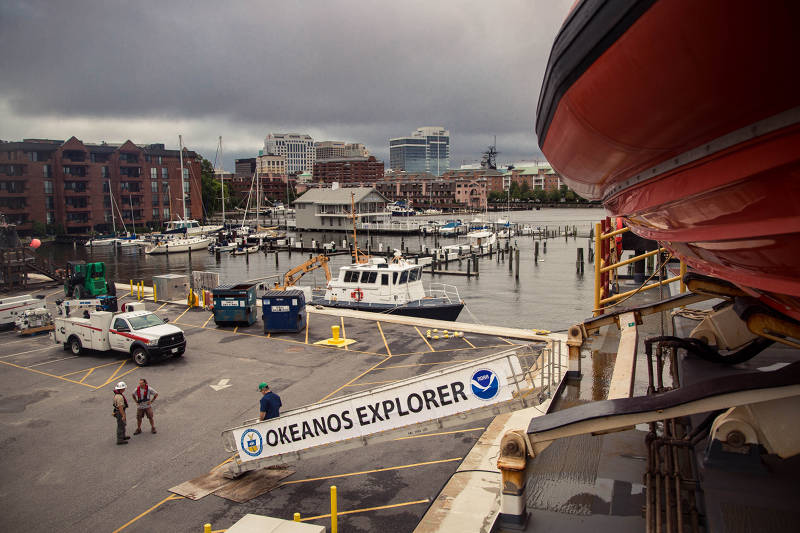
By Brian Kennedy - Expedition Coorinator, NOAA Office of Ocean Exploration and Research
September 18, 2014

NOAA Ship Okeanos Explorer in port. Image courtesy of the NOAA Office of Ocean Exploration and Research, Exploring Atlantic Canyons and Seamounts 2014. Download larger version (jpg, 4.5 MB).
A research vessel is a very complex operation. Not only do you have all of the state-of-the-art electronics on the remotely operated vehicles (ROVs) and sonars, but you have the entire engineering plant for the ship, that is honestly our life support systems.
Heat from the ship’s engines distill water for us to drink, we have to have a sewage treatment plant on board, and the propellers keep us moving and safe in a storm. To keep it all in working order is more than a full-time job for the six engineers on the ship. When all these systems hum along normally, they are out of sight and out of mind for the majority of the ship’s crew. We only think about them when something goes wrong or they are not operating at peak efficiency. When that does happen it can be hard to get replacement parts because marine-grade equipment is a relatively specialized and field replacement parts are not always quick to come by.
During Leg 2 of this expedition, a pump on one of our two water makers failed, which meant we could only make half as much water as we normally do. This causes several new factors to be considered in dive planning. Since the water makers use the heat of the engines to distill seawater into drinking water, we make more water when the engines are working harder. So on a calm day holding station for ROV operations, we make very little water. During nighttime operations, we have to work the engines harder to make up for the water we did not make during the ROV dive, meaning we have to run our mapping lines at a different speed than we prefer to. Sometimes we may even have to limit the number of hours we have the ROVs in the water in order to be able to make enough water.
In addition to the operational constraints, there are several things the ship’s crew has to endure while we are down a water maker. The first water conservation measure is to limit showers. Everyone starts taking a “Sea Shower,” which consists of getting wet in just a couple seconds then turning off the water to soap up, then quickly rinsing off. The second water conservation measure is to close the ship's laundry so no one can wash their clothes. The last normal water conservation measure is to switch the galley to paper plates so we don’t have to wash dishes.
Luckily for us, Okeanos’s Chief Engineer worked very closely with staff on shore to find a replacement part that could arrive in time to meet the ship in Baltimore. However, the part got hung up in customs and was going to arrive in Baltimore a day late. The expedition coordinator and the commanding officer of the ship were faced with a difficult decision - to get underway without the part and subject the crew to the hardships of water conservation measures or to lose an ROV dive waiting in port for the part.
In the hopes of getting the part and not losing a dive, the water maker part was redirected to Norfolk and the ship began its transit out of the Chesapeake, making her way to Norfolk, hoping the part would arrive by the time we got there. Unfortunately, the shipping company was not nimble enough to change the destination of the package with that short of notice, so when Okeanos arrived, the new pump had yet to make it to Norfolk.
In the end, it was decided to lose an ROV dive in favor of getting the part onboard. Our new plan is to begin our ROV dives on Friday, September 19, weather permitting. During the transit to our first dive site, the engineering department will install the new pump and, hopefully, Okeanos will be fully functional once again.